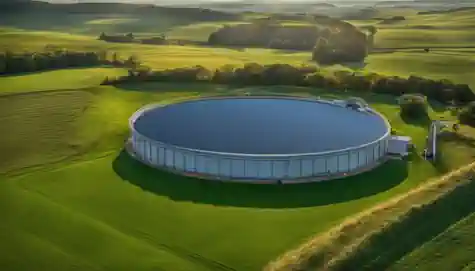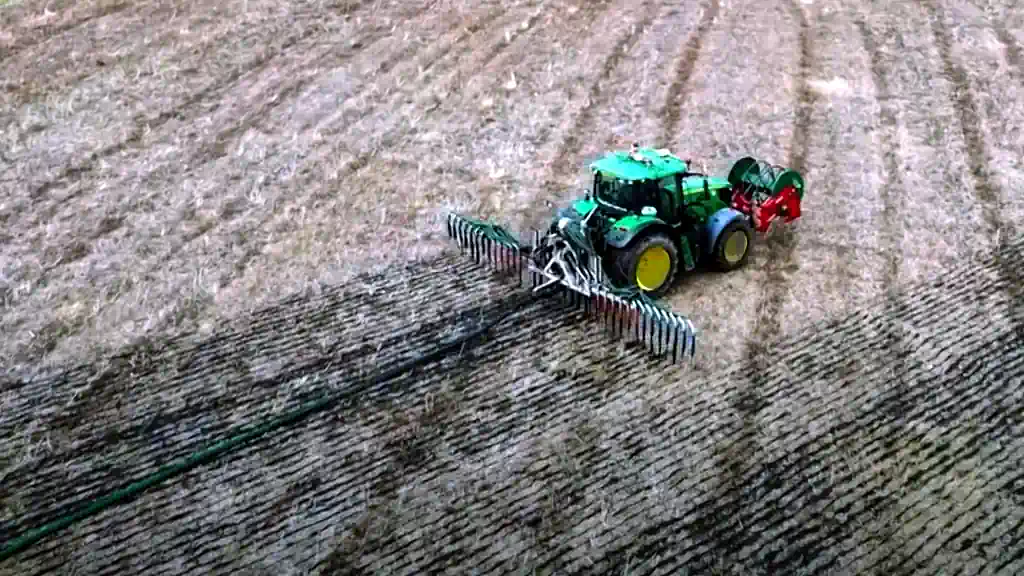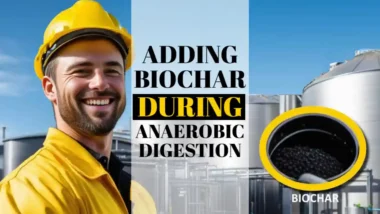Managing digestate storage can be tricky, and there is plenty of room for confusion given that digestate has two forms: liquid and solid fibres. One fact stands out: improper management of either can lead to environmental harm, but it is the liquid form that causes the most concern. This article will show you ways to store and manage liquid digestate responsibly, helping both the environment and your pocket.
For most digestates, the liquid form will simply run out of the solid content when just discharged onto a hard slab during the output of the slurry from a digester tank. Separation is also routinely achieved by using a simple augur screw separator, such as the Bioselect Separator supplied by our advertiser Borger.
Keep reading for insights that make a difference.
Key Takeaways
- Consult farm contractors to create a good liquid digestate storage plan. They can build tanks quickly and know the best ways to keep digestate safe.
- Choose strong and lasting storage methods like impermeable geomembrane-lined lagoons, and closed tanks, or use special bags. This keeps the environment safe and follows environmental protection and permit regulations.
- Check your storage system often for leaks or damage.
- Work with specialist companies that offer technology to monitor and process digestate into a value-added form of fertiliser. They turn digestate into useful low-carbon products helping farms and the environment.
- Keep learning about new ways to handle digestate better. Staying up-to-date means you can use waste wisely without harming nature.
What is Digestate Storage?

Digestate storage refers to the containment and proper management of the by-products produced from anaerobic digestion processes.
It involves preserving and safeguarding the output from the biogas digester tank(s) after digestion:
- liquid fertilisers,
- the fibre that is separated from the liquid, matured, often in the open air, and composted aerobically before being applied to the land as a combined fertiliser and soil structure improver.
As the storage of the fibrous digestate is a simple matter of providing a slab and turning it, following the procedures used for general composting practice, we make no further mention of it here. Organically contaminated run-off from this compost is collected and may possibly be treated in the same way as the liquid digestate.
Importance of storing digestate properly
Storing digestate (liquid) in carefully designed structures is key to avoiding leakage to keep the water in watercourses and the ground pollution-free. Leaks can damage the ecology of rivers and lakes. This nutrient-rich by-product from biogas production suits crop growth if used correctly.
The storage volume must be large enough to hold all the digestate produced during the winter period to use it as fertiliser during the growing season.
This helps to ensure that the digestate pays for itself by avoiding the need to buy expensive non-renewable chemical fertiliser.
Types of storage methods (open vs closed tanks, bags, etc.)
Managing digestate storage well is key to a successful operation. Knowing the right type of storage to use can make all the difference. Here are some common methods:
- Open Tanks: These are large containers without a top. They can hold a lot of digestate. The downside is that they might let out smells and gases into the air.
- Closed Tanks: Similar to open tanks, but with one major difference: they have a lid. This keeps odours and gases from escaping, making them better for places close to homes or businesses.
- Lagoons: Think of these as big ponds built just for digestate storage. They need lots of space but are good for large farms.
- Bags: Flexible and strong bags can also store digestate. They're great because you can move them around easily and they don't take up much space when not in use.
- Genap Silo System: This modern solution uses high-quality materials to safely store digestate, reducing the risks of leaks or spills.
- Floating Covers: For open tanks and lagoons, floating covers keep things tidy by reducing smells and stopping rainwater from getting in.
Each method has its place depending on your needs, like how much you need to store, what your budget is, and where your farm is. Choosing wisely helps with keeping costs down, staying legal, and being kind to neighbours and nature.

Next up: Why getting storage right benefits everyone involved in farming.
Benefits of Proper Digestate Storage
Proper liquid digestate storage improves fertilisation, reduces odours and emissions, and allows for cost-effective spreading. It also helps farms comply with regulations. Utilising recycling and hauling services is an effective strategy for managing digestate storage.
In the UK the storage of liquid digestate falls under the SSAFO regulations just the same as for farm manure slurry.
Improved fertilisation
Storing digestate the right way boosts its power to feed plants. This organic fertiliser comes from anaerobic digestion plants, making it a green choice for farms and gardens. It packs more nutrients than some chemical fertilisers, helping crops grow strong and healthy.
Using it means less need for artificial options that can harm our planet.
Recent studies show updated methods of treating digestate make it even better for the soil. These include hydrothermal carbonisation and thermochemical conversion processes. They help reduce bad impacts on the environment while making sure plants get all they need to flourish.
This approach supports a circular economy by turning waste into valuable resources again, like biomethane for renewable energy or nutrient-rich water for irrigation systems.

Reduced odours and emissions
Managing digestate well cuts down on bad smells and harmful gases. While it is not completely free of odour, when compared with raw slurry, digestate has a much lower odour than the digestate slurry. Most of the ability of the initial slurry to produce methane has been removed during the digestion process
Tanks hold the digestate safely, keeping methane and ammonia from getting into the air. In my work with handling pig slurry and chicken manure, closed tanks proved most effective.
They trap gases that can smell bad or harm our planet.
We also use a method called anaerobic digestion. This process breaks down waste without oxygen, reducing odour and emissions even more—especially when we inject the finished product into the soil instead of spreading it on top.
Such careful management means less pollution for everyone. Next, let's consider how managing digestate wisely helps save money during spreading.

Cost-effective spreading
Using digestate as fertiliser saves money and boosts crop yields. Digestate spreading uses the nutrients in waste to help plants grow. This method is cheaper than chemical fertilisers.
It also reduces the need for water and lowers farming costs.
Proper storage plays a key role here. It makes sure nutrients do not get lost before use. This keeps the soil healthy and crops strong, moving smoothly into how best to manage these resources efficiently.
Compliance with regulations
Meeting regulations is key for using anaerobic digestate safely. Rules set for minimum digestate quality, by the environmental regulatory bodies locally make sure we use this material without harming the environment.
They help us reach carbon neutrality too. Every treatment and storage plan must have an environmental permit.
This checks to prevent emissions at all steps.
The authorities set these rules under documents like the UK's Silage Slurry and Agricultural Fuel Oil Regulations 2010 (SSAFO). They include requirements to cover everything from odour nuisances to water pollution. Following them keeps the farm business legal and safe.
It's about protecting our air, soil, and rivers from harm while recycling waste into something useful.
Effective Strategies for Digestate Storage Management
Consult with farm contractors to devise a comprehensive storage plan that suits your specific needs. Learn more about tailored solutions for digestate management here.

Consulting with farm contractors
Farm contractors play a crucial role in setting up digestate storage systems quickly. They can sometimes build temporary tanks in less than two days of site erection time. This is great for those who need a place to keep digestate safe for a short time.
I have seen how these experts can work closely with farmers to choose the best storage solutions, like open or closed tanks, and bags that fit their needs.
Working with experts helps ensure that the digestate is stored correctly, reducing risks such as nutrients leaching into the ground or bad smells getting out into the air.
Their knowledge of handling different kinds of waste—like food leftovers or animal manure—and turning it into compostable material or biogas is invaluable. They guide you on how often maintenance checks should happen and what signs to look for if something is wrong with your storage setup.
Investing in durable storage solutions
When it comes to responsible digestate storage, investing in durable storage solutions is crucial. Properly managed digestate storage can offer farmers and landowners a good return on investment.
Anaerobic digestion has now been identified throughout the EU and in many other nations to be the preferred treatment for the organic fraction of municipal solid waste.
Heading into our next topic – “Proper Maintenance and Monitoring”…

Proper maintenance and monitoring
Proper maintenance and monitoring are crucial for efficient digestate storage. These strategies help ensure the optimal condition of the storage system and prevent potential environmental hazards from causing damage. Here are the key steps to effective maintenance and monitoring:
- Implement regular inspections of storage tanks to detect any signs of wear, corrosion, or leakage.
- Utilise monitoring tools such as gas sensors and temperature gauges to assess the condition of stored digestate.
- Conduct periodic sampling and testing to analyse nutrient levels, pH balance, and microbial activity within the digestate.
- Keep detailed records of maintenance activities, test results, and any corrective measures taken.
- Train staff on proper maintenance procedures and safety protocols for handling digestate storage equipment.
These measures contribute to sustainable waste management practices while ensuring compliance with regulatory standards.
Concepts: Resource Recovery, Organic Waste Repurposing
Conclusion
In conclusion, responsible digestate storage management is essential for maximising agricultural and environmental benefits.
By consulting with farm contractors, investing in durable storage solutions, and proper maintenance and monitoring, you can enhance the value of anaerobic digestates.
These strategies require investment, but they are well-proven, easy to implement, and efficient, leading to significant improvements in waste management practices. Applying these approaches not only reduces environmental impacts but also contributes to sustainable agricultural practices and decarbonisation.
If you seek further guidance on this topic, additional resources are available for continued learning or engagement beyond this article via specialist contractors based in your locality. Remember that effective digestate management, and especially the liquid portion of digestate is crucial for enhancing sustainability within the realm of waste management.
FAQs
1. What is digestate, and why does it matter?
Digestate comes from the breakdown of organic material, like food waste and animal slurries, in an anaerobic environment—meaning without oxygen. This process happens in places called anaerobic digesters. The end product can be used as a fertiliser because it's rich in nutrients.
2. How should we store digestate responsibly?
Storing digestate properly involves using leak-free tanks or reservoirs to prevent digestate leaks that could harm the environment.




